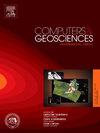AI-based geological subsurface reconstruction using sparse convolutional autoencoders
IF 4.4
2区 地球科学
Q1 COMPUTER SCIENCE, INTERDISCIPLINARY APPLICATIONS
引用次数: 0
Abstract
Subsurface reconstruction is critical for geological modeling and resource exploration. Conventional spatial interpolation methods are limited by stationarity and spatial isotropy assumptions, while advanced geostatistical techniques require specialized datasets. Deep learning approaches often need large datasets, which is impractical for geoscientific applications. This study presents an AI-based methodology using a sparse convolutional autoencoder for robust subsurface modeling under data constraints and integrating secondary data sources such as Vertical Electrical Sounding (VES) data. A four-stage testing framework was implemented: (1) emulating conventional interpolation for baseline performance; (2) reconstructing subsurface geometries from synthetic data; (3) incorporating geophysical constraints through VES forward modeling; and (4) validating the methodology using a real-world case study from the Huancayo tectonic basin in the Peruvian Andes, using 41 VES measurements across two cross-sections (12 and 14 km long). Results demonstrate that the proposed model effectively emulates kriging interpolation (mean squared error: 1.5 10 to 1.2 10 with 100–800 training examples) through transfer learning from an inverse-distance, pre-trained model. In subsurface reconstruction, the model outperforms kriging (37.4–61.7 % improvement across 1–15 % sampling densities) through its ability to adapt to non-stationary conditions. When incorporating synthetic VES data, the model effectively reconstructed subsurface geometries with error reduction from 4.1 10 to 9.1 10 as stations increased from 1 to 40, demonstrating diminishing returns beyond this point. Application to the Huancayo basin case study validated the model's practical applicability by successfully identifying previously unmapped features including the contact between basement and sedimentary infill, folds and faults. The methodology demonstrates the AI's capability to enhance geological understanding in complex tectonic settings, revealing subtle features and refining existing assumptions about subsurface architecture.

基于稀疏卷积自编码器的人工智能地质地下重建
地下重建是地质建模和资源勘探的关键。传统的空间插值方法受到平稳性和空间各向同性假设的限制,而先进的地质统计学技术需要专门的数据集。深度学习方法通常需要大型数据集,这对于地球科学应用来说是不切实际的。本研究提出了一种基于人工智能的方法,使用稀疏卷积自编码器在数据约束下进行鲁棒地下建模,并集成了垂直电测深(VES)数据等辅助数据源。实现了一个四阶段的测试框架:(1)模拟常规插值的基线性能;(2)利用合成数据重建地下几何形状;(3)通过地震探测正演模拟纳入地球物理约束;(4)利用秘鲁安第斯山脉万卡约构造盆地的实际案例研究验证了该方法,该研究使用了两个横截面(12和14公里长)的41个VES测量值。结果表明,该模型通过反距离预训练模型的迁移学习,有效地模拟了克里格插值(均方误差为1.5 × 10−3至1.2 × 10−3,训练样例为100-800)。在地下重建中,该模型通过适应非平稳条件的能力优于克里格法(在1 - 15%的采样密度下提高37.4 - 61.7%)。当结合合成的VES数据时,该模型有效地重建了地下几何形状,当站点从1个增加到40个时,误差从4.1 × 10−1减少到9.1 × 10−3,显示出超过该点的收益递减。在Huancayo盆地的应用验证了该模型的实用性,成功地识别了基底与沉积充填体之间的接触、褶皱和断层等以前未映射的特征。该方法展示了人工智能在复杂构造环境中增强地质认识的能力,揭示了微妙的特征,并完善了关于地下结构的现有假设。
本文章由计算机程序翻译,如有差异,请以英文原文为准。
求助全文
约1分钟内获得全文
求助全文
来源期刊

Computers & Geosciences
地学-地球科学综合
CiteScore
9.30
自引率
6.80%
发文量
164
审稿时长
3.4 months
期刊介绍:
Computers & Geosciences publishes high impact, original research at the interface between Computer Sciences and Geosciences. Publications should apply modern computer science paradigms, whether computational or informatics-based, to address problems in the geosciences.
 求助内容:
求助内容: 应助结果提醒方式:
应助结果提醒方式:


